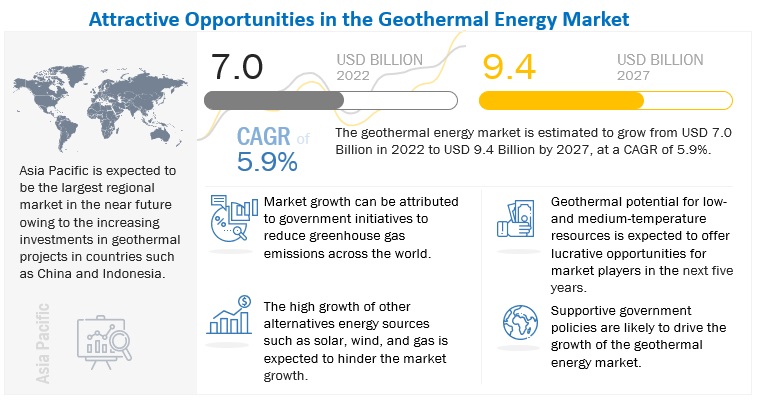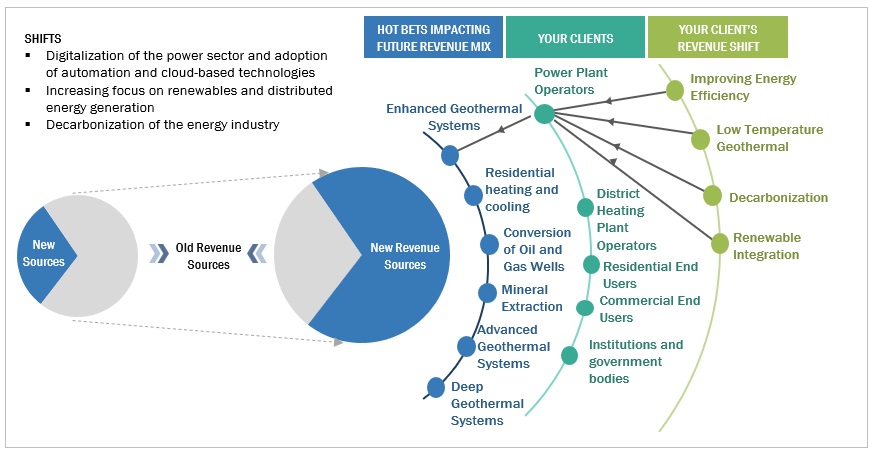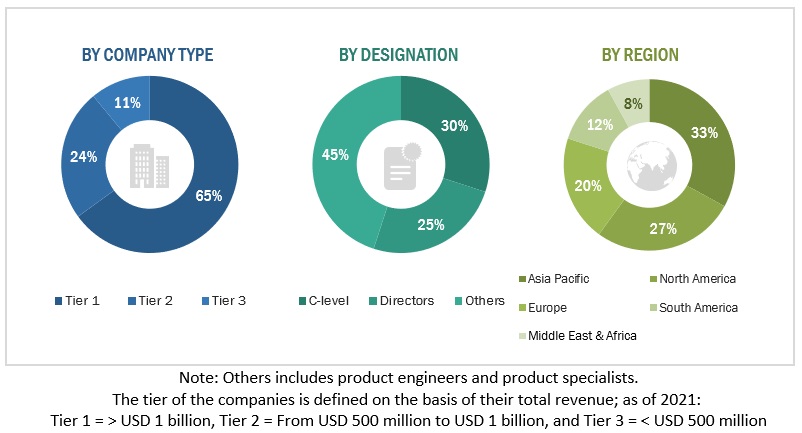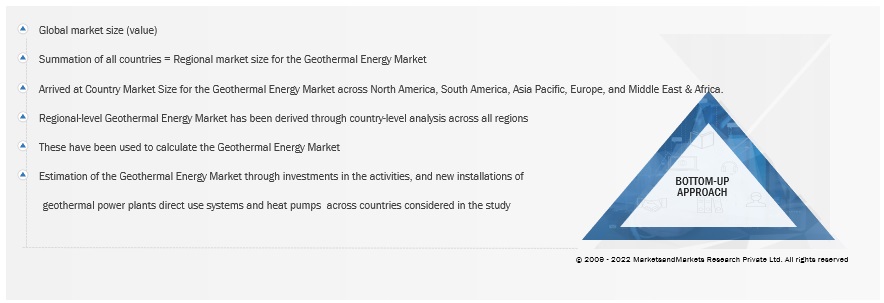Geothermal Energy Market by Application (Power Generation, Residential & Commercial Heating And Cooling), Temperature, Technology (Binary & Flash Cycle Plant, Dry Steam Plant, Ground Source Heat Pumps, Direct Systems) & Region - Global Forecast to 2027
[286 Pages Report] The global geothermal energy market size was valued at $6.6 Billion in 2021, and geothermal energy industry is projected to reach $9.4 billion by 2027, growing at a CAGR of 5.9% from 2022 to 2027. Increasing demand for constant power supply among residential, commercial, and industrial sectors, and growing demand for electricity generation through sustainable means in industries are the major driving factor for the geothermal energy market.

To know about the assumptions considered for the study, Request for Free Sample Report
Geothermal Energy Market Dynamics
Driver: Rising demand for power generation through sustainable means
Geothermal electricity generation relies mainly on technologies that exploit conventional geothermal resources, such as dry steam plants, flash plants (single, double, and triple), binary plants, and combined cycle or hybrid plants. However, as high-quality conventional resources become harder to access, deeper resources may become accessible in the future through the development of enhanced geothermal systems.
At the end of 2021, the total installed geothermal power generation capacity stood at 15,960 MW. Additional capacity was added in several countries along with Colombia and Taiwan which have added geothermal power newly in the year. The US is the leading producer of geothermal electricity in the world. In 2021, there were geothermal power plants in California, Nevada, Utah, Oregon, Hawaii, Idaho, and New Mexico, which produced about 16.2 billion kilowatt-hours (kWh) equal to about 0.4% of total US utility-scale electricity generation. By 2050, geothermal power output in and outside of the western part of the US may be significantly increased to offer 60+ gigawatts electric (GWe) of reliable, flexible clean energy.
Restraint: Lack of exploration and drilling techniques
Drilling, constructing, and operating wells in harsh geothermal environments require advanced techniques and technologies relative to drilling for water or oil and gas. Geothermal drilling is plagued by nonproductive time related to lost circulation, drill bit trips, and inefficiencies due to low penetration rates and damaging drilling dynamics. Enhancements in drilling efficiency and system performance are taking place slowly and the upfront drilling cost is growing significantly. Drilling operations comprise a major part of the cost of geothermal development, so more efficient drilling can reduce risk and cost and help increase geothermal development in the near term. Companies are working to advance high-temperature/hard-rock geothermal drilling. Currently, geothermal drilling averages 125 ft/day through hard rock and crystalline formations, making it time-consuming and expensive compared with petroleum industry drilling.
Unlike short-lived oil and gas wells, geothermal wells must last decades under constant use and harsh conditions and require well materials (both casing and cement backing) that can survive for years in temperatures over 300°C and in potentially highly saline (>1M) fluid. Similarly, downhole data collection in the oil and gas industry has decreased drilling time and cost and increased penetration rates by 35%–55%. Drilling time can be reduced by 50% by optimizing geothermal drilling through new sensing and electronics technologies. There is a need to develop new downhole drilling and data collection tools using new materials and designs to increase the temperature and pressure capability of these tools for use in high-temperature (>250°C) geothermal wells. Current downhole sensor technology is not reliable over 150°C, while anticipated drilling environments for geothermal surpass 400°C.
Opportunities: Geothermal potential for low- and medium-temperature resources
Low-to-moderate temperature geothermal energy is defined as heat obtained from the geothermal fluid in the ground at temperatures of 300°F (150°C) or less. These systems represent a significant energy resource for the world but are economically challenging for electric power generation. In addition to the challenges for all geothermal development (exploration, permitting, financing, and operation), low-temperature resources have low exergy and corresponding efficiencies for converting the heat to electricity. Some low-temperature resources can be harnessed to generate electricity using binary cycle electricity generating technology. These resources are typically used in direct-use applications, such as district heating, greenhouses, fisheries, mineral recovery, and industrial process heating. Low-temperature geothermal energy resources can be used by different community customers, including urban centers, rural areas, and remote communities.
Very low-temperature geothermal energy can be recovered from heat sources under 30°C. This geothermal energy can be used for heating applications through heat pumps. These system applications include homes, apartments and commercial buildings such as offices, and malls. Urban planners are increasingly using very low-temperature geothermal energy to heat and cool large complexes. Low-temperature resources have the potential to contribute largely to the global geothermal portfolio. The US Geological Survey has identified more than 120,000 megawatts of untapped low-temperature geothermal resources in the US. These resources are typically found in the eastern US states. In 2021, the US DoE announced ~USD 15 million for research and development to help grow US low-to-moderate temperature geothermal resources and co-produced resources. The government is working toward achieving widespread production of low-temperature power through the surface and down-hole technology advances, improved education and outreach, and increased collaboration between government and industry. Globally, Very low-temperature geothermal energy is being increasingly used by urban planners to heat and cool large complexes. Low-temperature resources have the potential to contribute largely to the global geothermal portfolio.
Challenges: Environmental disruptions have caused various challenges to the process of geothermal energy extraction
Regulatory agency staff funding and availability to approve and process geothermal lease nominations may extend development timelines, particularly when involving separate federal and state land management agencies. Geothermal development is also subject to timelines in the review and processing stages in federal permitting. Federal and state permitting office staff have various experiences and varied processes. At the federal level, field offices in areas that already have geothermal projects often have federal leasing and permitting staff who are familiar with geothermal development. Still, staff in areas without geothermal projects can lack the experience necessary to process new geothermal applications. Delays can also occur in locations with experienced staff when geothermal experts are unavailable due to competing priorities or other reasons. Furthermore, data from the exploration and resource-confirmation phases of a geothermal project determine whether and how to proceed with developing the project. Under existing processes, each phase in the geothermal development process may require subsequent environmental reviews.
The length and number of environmental reviews for a single geothermal project can impact geothermal deployment. More than 40% of the US geothermal electricity capacity is located on leases issued by the Bureau of Land Management. Geothermal projects on federally managed land in the US may be subject to an environmental review process under NEPA at least six times from agency land-use planning through the construction of a power plant and associated transmission infrastructure. As multiple reviews and NEPA analyses are required, confirming the resource is more costly and risky. The delay and need for additional steps can result in a 5–7-year period (rather than a 1–3-year period) for a permit applicant to demonstrate a bankable geothermal development.
Laws exist both on the federal level (Bund) and on the state level (Länder). Geothermal energy in Germany is governed by the Federal Mining Act (Bundesberggesetz). French legal regulations of geothermal operations are based upon two main decrees. Decree 77-620 (16 June 1977) added a new title “Low temperature geothermal deposits” to the Mining Law (Code Minier), creating an obligation to obtain an exploration permit before drilling and an exploitation permit before starting up production. Decree 74-498 (24 March 1978) defined legislation concerning “Geothermal prospecting and exploitation licenses”. According to these decrees, geothermal resources are considered concessible and therefore assimilated into mines. All drillings deeper than 100m are ruled by the Mining Code and thus subject to a declaration to the competent authority, Direction Regionale de l'Industrie, de la Recherche et de l'Environnement (DRIRE), which is linked to the Ministry of Industry through Direction Générale de l'Energie et des Matières Premières (DGEMP). Similarly, several laws cover the issues of geothermal development in Hungary: Mining Law (no. XLVIII,1993); Water Management Law (no. LVII, 1995); Concession Law (no. XI, 1991). In the use of thermal waters, the components of water, production (reinjection) well(s), and land property are dealt with by different laws.
Market Trends

To know about the assumptions considered for the study, download the pdf brochure
Commercial Heating and Cooling segment, by application, is expected to grow at the highest CAGR during the forecast period
By application, the geothermal energy market has been segmented into power generation, residential heating and cooling, commercial heating and cooling, and others. In the commercial, Geothermal Energy is mainly used for commercial applications such as space and water heating. As geothermal energy is continuously being adopted in office buildings to reduce electricity consumption. Many of the warehouses are used geothermal energy to heat asphalt to the desired temperature. The increasing demand for energy for smaller business establishments is driving the geothermal market in the commercial heating and cooling segment.
By Temperature, the low temperature segment is expected to be the second-largest during the forecast period
By temperature, the geothermal energy market has been segmented into low temperature, medium temperature, and high temperature. Low temperature geothermal resources are commonly used for direct applications such as heating and recreation. Almost anywhere in the world, geothermal heat can be harnessed and used immediately as a heat source. This heat energy is mostly found in pockets of low-temperature zones that are found a few meters below ground. For centuries, these geothermal energy pockets have been used by people for cooking, comfort, healing. The growth of the low temperature segment is attributed to the easy availability of geothermal energy through vents and geysers and the increasing adaptation of geothermal heat pumps in homes.
Asia Pacific is expected to be the largest geothermal energy market during the forecast period
Asia Pacific is expected to be the largest region in the geothermal energy market in 2021 and is also the fastest-growing region. In Asia Pacific, various countries are currently focused on geothermal energy to meet the increasing demand for electricity and to achieve the net zero emission of CO2 goal. Geothermal resources are abundant in Asia pacific countries such as Indonesia and New Zealand and can be utilized as climate-friendly energy sources in all weather. For these factors, there are huge investments going on from both government and private companies.

Key Market Players
The market is served by a mix of large international players with operational presence across the globe and local players commanding a strong supply network in the domestic market. The leading players in the global geothermal energy market include Ormat (US), Mitsubishi Heavy Industries (Japan), Baker Hughes Company (US), NIBE Group (Sweden), and SLB (US). Strategies such as product launches, contracts, agreements, partnerships, collaborations, alliances, acquisitions, and expansions are followed by these companies to increase their market share.
Geothermal Energy Market Report Scope
|
Report Coverage |
Details |
|
Market size: |
USD 7.0 billion in 2022 to USD 9.4 billion by 2027 |
|
Growth Rate: |
5.9% |
|
Largest Market: |
Asia Pacific |
|
Market Dynamics: |
Drivers, Restraints, Opportunities & Challenges |
|
Forecast Period: |
2022-2027 |
|
Forecast Units: |
Value (USD Billion) |
|
Report Coverage: |
Revenue Forecast, Competitive Landscape, Growth Factors, and Trends |
|
Segments Covered: |
Geothermal Energy Market by Technology, Temperature, Application, and Region |
|
Geographies Covered: |
Asia Pacific, North America, Europe, Latin America, and Middle East and Africa |
|
Report Highlights:
|
Updated financial information / product portfolio of players |
|
Key Market Opportunities: |
Emergence of advanced technologies and rise of Geothermal 2.0 |
|
Key Market Drivers: |
Rising demand for power generation through sustainable means |
This research report categorizes the market by technology, temperature, application, and region
On the basis of technology, the geothermal energy market has been segmented as follows:
- Binary Cycle Plants
- Flash Steam Plants
- Dry Steam Plants
- Ground Source Heat Pumps
- Direct Systems
- Others
On the basis of temperature, the geothermal energy market has been segmented as follows:
- Low Temperature (Up to 900C)
- Medium Temperature (900C – 1500C)
- High Temperature (Above 1500C)
On the basis of application, the geothermal energy market has been segmented as follows:
- Power Generation
- Residential Heating and Cooling
- Commercial Heating and Cooling
On the basis of region, the market has been segmented as follows:
- Asia Pacific
- Europe
- North America
- Middle East & Africa
- South America
Recent Developments
- In July 2022, Ormat announced the commercial operation of the Casa Diablo-IV (CD4) 30 MW geothermal power plant. The CD4 facility provides 7 MW of geothermal power to two Community Choice Aggregators, Silicon Valley Clean Energy and Central Coast Community Energy, each under a 10-year power purchase agreement (PPA). In addition, the facility provides 16 MW of geothermal power to the Southern California Public Power Authority under a 25-year agreement.
- In March 2021, Ormat launched a new, high-performance between-bearings turbine. By utilizing the traditional radially split design, the turbine rotor in the new product is supported between the axially spaced bearings.
- In May 2021, Iberdrola and Mitsubishi Power, a subsidiary of Mitsubishi Heavy Industries signed a collaboration agreement to jointly develop competitive, clean and safe energy solutions based on renewable energy that promotes the decarbonization of industrial production in different regions around the world.
- In May 2022, Baker Hughes Company announced an investment in San Francisco-based GreenFire Energy Inc., a company involved in the development of closed-loop Advanced Geothermal Systems (AGS). The companies plan to expedite geothermal resources development by retrofitting both existing non-producing geothermal and oil and gas wells to closed-loop heat-producing wells for power generation and direct-use applications. In addition, Baker Hughes and GreenFire Energy will collaborate on project feasibility analyses, system installations, and global project developments.
- In February 2022, SLB announced the introduction of the GeoSphere 360 3D reservoir mapping-while-drilling service at the International Petroleum Technology Conference (IPTC). The service uses advanced cloud and digital solutions to deliver real-time 3D profiling of reservoir objects. This improves reservoir understanding and enhances well placement to improve the returns from complex reservoirs.
Frequently Asked Questions (FAQ):
What is the current size of the geothermal energy market?
The current market size of the geothermal energy market is 6.6 Billion in 2021.
What are the major drivers for the geothermal energy market?
Rising demand for power generation through sustainable means and the need for cost efficient cooling are some of the major driving factors for the geothermal energy market
Which is the fastest-growing region during the forecasted period in the geothermal energy market?
Asia Pacific is expected to dominate the geothermal energy market between 2022–2027, followed by Europe and North America. The favorable government policies and the need for cost efficient residential heating are the reasons for the region’s significant market size.
Which is the largest segment, by application during the forecasted period in the geothermal energy market?
The power generation segment is expected to be the largest segment by application during the forecast period
To speak to our analyst for a discussion on the above findings, click Speak to Analyst
The study involved major activities in estimating the current size of the geothermal energy market. Exhaustive secondary research was done to collect information on the peer and parent markets. The next step was to validate these findings, assumptions, and sizing with industry experts across the value chain through primary research. Both top-down and bottom-up approaches were employed to estimate the complete market size. Thereafter, market breakdown and data triangulation were used to estimate the market size of the segments and subsegments.
Secondary Research
This research study on the geothermal energy market involved the use of extensive secondary sources, directories, and databases, such as Hoovers, Bloomberg, Businessweek, IEA Geothermal, International Energy Agency, and BP Statistical Review of World Energy, to identify and collect information useful for a technical, market-oriented, and commercial study of the market. The other secondary sources included annual reports, press releases & investor presentations of companies, white papers, certified publications, articles by recognized authors, manufacturer associations, trade directories, and databases.
Primary Research
The market comprises several stakeholders such as power plant manufacturers, ground source heat pump manufacturers, manufacturing technology providers, and technical support providers in the supply chain. The demand side of this market is characterized by the rising demand for geothermal energy in, power generation, residential heat & cooling, commercial heat & cooling, and others applications. The supply side is characterized by rising demand for contracts from the industrial sector, and mergers & acquisitions among big players. Various primary sources from both the supply and demand sides of the market were interviewed to obtain qualitative and quantitative information. Following is the breakdown of primary respondents:

To know about the assumptions considered for the study, download the pdf brochure
Market Size Estimation
Both top-down and bottom-up approaches were used to estimate and validate the total size of the geothermal energy market. These methods were also used extensively to estimate the size of various subsegments in the market. The research methodology used to estimate the market size includes the following:
- The key players in the industry and market have been identified through extensive secondary research, and their market share in the respective regions have been determined through both primary and secondary research.
- The industry’s value chain and market size, in terms of value, have been determined through primary and secondary research processes.
- All percentage shares, splits, and breakdowns have been determined using secondary sources and verified through primary sources.
Geothermal Energy Market Size: Bottom-Up Approach

To know about the assumptions considered for the study, Request for Free Sample Report
Data Triangulation
After arriving at the overall market size from the estimation process explained above, the total market has been split into several segments. To complete the overall market engineering process and arrive at the exact statistics for all the segments and subsegments, the data triangulation and market breakdown processes have been employed, wherever applicable. The data has been triangulated by studying various factors and trends from both the demand- and supply sides. Along with this, the market has been validated using both the top-down and bottom-up approaches.
Objectives of the Study
- To define, describe, segment, and forecast the geothermal energy market on the basis of technology, temperature, application, and region
- To provide detailed information on the major factors influencing the growth of the market (drivers, restraints, opportunities, and challenges)
- To strategically analyze the market with respect to individual growth trends, future expansions, and the contribution of each segment to the market
- To analyze market opportunities for stakeholders and details of the competitive landscape for market leaders
- To forecast the growth of the market with respect to the main regions (Asia Pacific, Europe, North America, South America, and Middle East & Africa)
- To strategically profile key players and comprehensively analyze their market rankings and core competencies
- To track and analyze competitive developments in the market, such as contracts and agreements, investments and expansions, new product developments, and mergers and acquisitions
Available Customizations:
With the given market data, MarketsandMarkets offers customizations according to your specific needs. The following customization options are available for a report:
Product Analysis
- Product matrix, which provides a detailed comparison of the product portfolio of each company
Company Information
- Detailed analyses and profiling of additional market players



 Generating Response ...
Generating Response ...







Growth opportunities and latent adjacency in Geothermal Energy Market